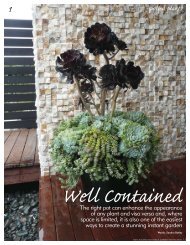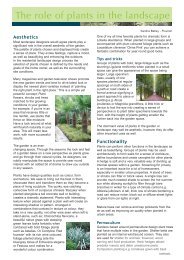Create successful ePaper yourself
Turn your PDF publications into a flip-book with our unique Google optimized e-Paper software.
<strong>Gardens</strong> | Waterwise <strong>Gardens</strong><br />
Making Each<br />
Drop Count<br />
Landscape designer Sandra Batley provides simple<br />
water-conscious design solutions for your garden.<br />
Although we don’t think of New Zealand as a dry<br />
country water conservation takes on greater significance over the<br />
summer period when consumption rises by up to 50%. A massive<br />
amount of our cities' water supplies goes on watering gardens<br />
and outdoor use, resulting in several regions around the country<br />
implementing restrictions to combat the problem.<br />
As any experienced gardener will tell you, the secret to<br />
a healthy garden has more to do with preparation and how<br />
effectively you use water, rather than how much you use. So by<br />
employing some simple, yet effective procedures your plants and<br />
lawn areas will be green, healthy and you’ll save water too.<br />
Photo Lisa Gane. Ellerslie International Flower Show Exhibition Garden entry 2010.<br />
homestyle | Feb/Mar 11 | 145
<strong>Gardens</strong> | Waterwise <strong>Gardens</strong><br />
Waterwise Planting<br />
Planning a waterwise garden involves selecting plants which are<br />
appropriate to the site. Choose plants with similar water needs and<br />
soil types, and plant them in groups. This enables you to irrigate more<br />
effectively without wasting water, creating a landscape that can be<br />
maintained and flourish with minimal watering.<br />
There are many interesting planting themes you can design into your<br />
garden to further reduce the demand on our water supplies especially<br />
during the critical summer season.<br />
Hebe Oratia<br />
Native Planting<br />
The wonderful thing about native plants is<br />
that they are accustomed to local conditions,<br />
they need little maintenance and are well<br />
adapted to survive local conditions with<br />
minimum fuss and water. New Zealand<br />
has a wide and interesting palette of native<br />
species that will allow you to create an<br />
interesting look all year round. Think hebes,<br />
coprosma, flaxes, grasses, pohutukawa,<br />
corokia and astelia. They work well<br />
especially in coastal areas where full dense<br />
planting can be achieved.<br />
Cistus<br />
Lavender<br />
Mediterranean Style<br />
Aromatic and colourful plantings of cistus,<br />
bougainvillea, lavenders and olives. These plants just<br />
love the hot sun, as long as the drainage is good, you can<br />
create the feeling of a Provencal landscape.<br />
146 | Feb/Mar 11 | homestyle
Astelia (silvery colour foliage)<br />
Aloe plicatilis<br />
Hot-Dry Subtropical<br />
These plants are fairly drought tolerant and have a distinctive striking<br />
architectural form. Most, however perform better with some regular<br />
watering as well as good drainage. They are generally identified by their<br />
bluish or silver tinge foliage colour. Consider aloe plicatilis, dracena<br />
draco, aloe banksii, nolia recurvata, butia capitata and gazania hybrids.<br />
Petunia<br />
Traditional<br />
This is a versatile style which can also be created in dry areas, using plants that<br />
require little or no extra water and work with the climate. Consider gazania, arcotis,<br />
lavender, portulaca, petunia, agapanthus and convolvulous.<br />
ABOVE If you want to create a traditional style garden that is still water wise, do so<br />
using flowering carpet roses. These are low maintenance roses which lend themselves<br />
to mass plantings. Once established they become quite drought resistant.<br />
Lavender<br />
homestyle | Feb/Mar 11 | 147
8 Ways to Reduce<br />
Water Consumption When Watering<br />
1. Check soil moisture before watering. If your soil is moist 10<br />
centimeters below the surface, you don’t need to water.<br />
2. Only water on calmer days, in the cool of the early morning or<br />
evening, so that the benefit of your watering last longer as wind and<br />
sun will cause evaporation.<br />
3. Water close to the ground at a rate the soil can absorb. Plants take<br />
up moisture through their feeder roots and low, slow watering is the<br />
best way to get it there.<br />
4. Don't over-water, as this will encourage fungus, root rot, rusts,<br />
mildew and black spot to occur.<br />
5. Soak; don't sprinkle. Less frequent, deep soakings encourage<br />
feeder roots to grow deeply in search of water. This will help<br />
your plants to survive short-term drought conditions. Frequent<br />
light sprinklings of water encourage shallow roots that are more<br />
vulnerable in dry weather.<br />
6. Established plants only need half an hour of watering once or twice<br />
a week in dry weather, as long as the water can soak into the ground.<br />
7. Control your hose with a trigger. A trigger device lets you stop and<br />
start the water flow from your hose instantly.<br />
8. Mulch is a thick cover of organic or inorganic material laid over<br />
garden beds. It reduces exposure to wind, helps to hold and build the<br />
soil, prevents weeds and keeps water in the root zone wood chips.<br />
Recycling Water<br />
What happens when there is too much rain? When there is an abundance of<br />
water, one of the easiest ways to collect rainwater is from the roof of your house,<br />
garage or shed and store it in a tank until you need it. Rainwater is free and<br />
a perpetually renewing water supply for irrigating your garden. Installing a<br />
rainwater tank is relatively simple and inexpensive.<br />
Gardeners can also reduce water pollution associated with heavy downpours<br />
by developing rain gardens, which capture storm water runoff and help prevent<br />
it from entering local lakes, streams, and coastal waters. Raingardens are a<br />
stunning way of holding stormwater runoff in your own backyard, filtering and<br />
absorbing runoff before it is released back into the public stormwater system.<br />
Grey water used in the home, for washing and bathing, can be reused in<br />
your garden as long as you adhere to a few simple rules. Never re-use water<br />
containing strong chemicals or detergents as it can have a negative impact on<br />
your garden, and always allow the water to go cold before re-using it. Also, never<br />
use grey water on edible crops or leaves for risk of contamination. •<br />
Sandra Batley is an award-winning landscape designer and owner operator of Aucklandbased<br />
innovative garden design company Flourish, www.flourishgardens.co.nz

















